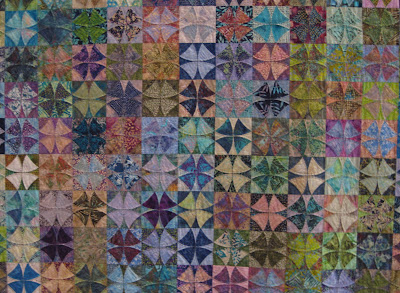Last week I basted together a quilt sandwich - pieced top, heirloom wool batting and backing- and began quilting it all together.
These are my tools:
A 22.5" quilting hoop, which I've had for so long
I can't even remember where I purchased it
Metal thimbles
1/4" inch quilter's tape
John James Stainless Steel Quilting needles, size 8
Gutermann quilting thread
Template plastic for making my own templates
Pat Campbell marking pencil, white
Thread Heaven silicon thread conditioner
which I've kneaded into a lump
 A close-up - note the newer thimble, which has a ridge encircling the upper surface - only for use as the top thimble.
A close-up - note the newer thimble, which has a ridge encircling the upper surface - only for use as the top thimble.  My basting work surface - a freshly vacuumed floor.
My basting work surface - a freshly vacuumed floor.You can see the batting and backing are oversized and will be trimmed later.
This quilt is a favorite traditional pattern, Snowball, in fabrics designed by Martha Negley, paired with two of Kaffe Fassett's Shot Cotton solids.
Good light is essential for hand-quilting, and, like lace-makers of old, I work close to a window, but also have a desk-top fluorescent Luxo lamp; not so good for color rendition but fine for directed illumination. When I demo hand-quilting I travel with my Ott floor lamp.
 The red thread is my hand basting, which holds the layers together.
The red thread is my hand basting, which holds the layers together.A contrast color makes is easier to remove
the basting thread when the quilting is complete.
the basting thread when the quilting is complete.
I begin with the solid green areas, quilting to highlight the lozenge shape. The hoop tensions the area evenly.
 Using the quilter's tape to get even spacing,
Using the quilter's tape to get even spacing, I start in the middle of a piece, well away from edges and seams.
After running the thread through the silicon conditioner, I just make a double knot in the thread and pull the thread through the backing only, burying the knot in the layers.
The needle bounces off the under thimble and is pushed with the upper thimble. Since Dritz no longer makes the traditional thimble without ridges, I will have to hunt for used thimbles once mine wears out.
Once I've finished the solid green areas, I mark the diagonals using a metal ruler and the marking pencil.
Generally, the white markings will have worn off by the time I've finished quilting. If need be, a fabric eraser can be used to remove any lingering traces of marking.
 A 3.5" circle, cut from template plastic, positioned
A 3.5" circle, cut from template plastic, positionedwithin the 4" circle already drawn.
I align the grid of the template with the white marked diagonals, to ensure the circles are centered.
 Twin needle quilting.
Twin needle quilting.With the first snowball quilt I made, I quilted a single circle to make the "snowball". Upon reflection, this looked a little wimpy, so subsequent quilts have a double line of quilting to make a more emphatic circle shape. To speed things up I use two needles - I'll quilt the outer circle, then the inner curve, and then re-position my hoop, since much of the time taken by hand-quilting is in adjusting the position of the hoop.












































